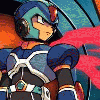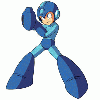
Mega Man
CBUB Wins: 16
CBUB Losses: 5
CBUB Ties: 0
Win Percentage: 76.19%
Added by: Dragoon3k5
in Japan, is a cybernetic video game character, created by Akira Kitamura and designed by Keiji Inafune and is the title character of what has been referred to as the original Mega Man series developed by Capcom since 1987. Since then, he has become one of the company's primary original characters and continues to be one of the video game industry's most recognizable icons. Having appeared on many gaming systems since the Nintendo Entertainment System, Mega Man has had a wide gaming audience, and his games continue to evolve with the ever-changing hardware demands of modern gaming systems. Mega Man's fictional universe can be divided into seven categories, each featuring different variations and incarnations of a cyborg boy hero. Although "Mega Man", or "Rockman", is usually the name used to describe only the original Mega Man from the classic series, it can also be used less specifically to describe the Mega Man series of fictional works, or the group of adherently named main characters within.
The several spin-off series that have emerged over the past years, each one continuing the Mega Man mythos in some unique way, includes but is not limited to the Mega Man X, Mega Man Legends, Mega Man Battle Network, and Mega Man Star Force series. A resulting animated series was also produced originally in Japan as well as a number of toy, comics, and collectable available both in and outside of Japan.
Mega Man's role in the original story is to battle the mad scientist Dr. Wily and his ever-growing army of cyborgs, and stop them from taking over the planet by using their own special abilities against them. Utilizing his special Mega Blaster arm cannon (becomes the Mega Buster starting with Mega Man IV), and his ability to copy a defeated cyborg's special weapon. Mega Man must travel the world and traverse harsh environments in order to bring Wily's menace to an end. With the help of his creator Dr. Light and his assorted cybernetic companions, Mega Man's eventual goal is to one day achieve "everlasting peace".
Although originally the names "Mighty Kid" and "Knuckle Kid" were proposed, Capcom eventually settled on "Rockman" as Mega Man's Japanese moniker. The name "Rainbow Man" was also proposed, due to his ability to change color. The word "Rock" in Rockman is a reference to the music genre rock and roll, and is meant to work in tandem with his "sister" robot, Roll. However, Capcom Consumer Products Division president Joe Morici changed the name from Rockman to Mega Man because he simply did not like the name stating "The title was horrible." Such music-themed naming conventions are present in a number of Keiji Inafune's other character designs, such as Blues. In addition, the original Mega Man titles intentionally incorporated a "Rock, Paper, Scissors" gameplay mechanic into defeating certain enemies.
Images with a green border may be set as the character's main profile image (For images 200x200 or 300x300 pixels square).
CBUB Match Record:
| Result | Opponent | My Score | Their Score | |
|---|---|---|---|---|
| Win | Mario | 258 | to | 218 |
| Loss | Sonic the Hedgehog | 42 | to | 45 |
| Win | Protoman | 62 | to | 23 |
| Win | Eduardo | 88 | to | 15 |
| Win | KOS-MOS | 68 | to | 32 |
| Win | Baby Bonnie Hood | 70 | to | 27 |
| Win | Zero (Mega Man X) | 67 | to | 42 |
| Loss | Master Chief | 46 | to | 59 |
| Win | Nuclear Man | 68 | to | 35 |
| Loss | Samus Aran | 25 | to | 34 |
| Win | T-800 (The Terminator) | 58 | to | 45 |
| Win | Stinkoman | 63 | to | 28 |
| Win | Astro Boy | 68 | to | 18 |
| Win | Cyborg (DC) | 66 | to | 52 |
| Win | Captain N | 67 | to | 23 |
| Win | Rogue | 69 | to | 50 |
| Win | Han Solo | 71 | to | 42 |
| Loss | Iron Man | 46 | to | 77 |
| Loss | Doctor Doom | 14 | to | 17 |
| Win | T-800 (The Terminator) | 16 | to | 6 |
| Win | Cybermen | 19 | to | 4 |
No Fantasy Draft Records Available





